Homemade pasta, oh boy! This homemade pasta recipe is easy to follow and only 4 ingredients! There’s nothing quite like it, and you don’t need to be a kitchen wizard to whip up a batch. Homemade pasta noodles are simply the bomb compared to their storebought counterparts. First off, the taste is on a whole new level – they’re like little strands of heaven in your mouth. So, why settle for the generic stuff when you can have a plate of homemade pasta that’s not just delicious but also made with love? Making pasta from scratch can be a fantastic family activity or a romantic date-night adventure. My husband loves making homemade pasta. It can be a fun activity for the whole family.
With a trusty KitchenAid stand mixer and its pasta attachment, making your very own pasta noodles becomes a breeze. But hey, don’t fret if you don’t have one – you can also roll and cut pasta using just a good old knife. So, let’s get rolling and cutting with this homemade pasta recipe!
THIS POST MAY CONTAIN AFFILIATE LINKS. PLEASE SEE MY FULL DISCLOSURE POLICY FOR DETAILS. AS AN AMAZON ASSOCIATE I EARN FROM QUALIFYING PURCHASES.
Ingredients Needed For Homemade Pasta
Flour – All – purpose flour, you can also use oo flour or semolina flour. I find all-purpose flour is perfect for this recipe.
Eggs – Eggs add moisture, richness, and flavor to the pasta dough. They also act as a binding agent, helping to hold the dough together. The yolks contribute to the dough’s color and make it more tender, while the egg whites provide protein for structure.
Salt –Salt enhances the flavor of the pasta dough. It also helps strengthen the gluten network formed in the dough, which contributes to its elasticity and chewiness. Additionally, salt can help control the rate of fermentation, improving the texture of the pasta.
Olive Oil – Olive oil is added to the pasta dough to provide a subtle flavor and make the dough more pliable. It can help prevent the dough from becoming too dry and crumbly, especially if the dough is being rolled out by hand or with a pasta machine.
How To Make Homemade Pasta
Using your mixer method
In your KitchenAid stand mixer bowl, add the flour and salt, stir well and make a little well in the middle. Crack the eggs into the well and pour the olive oil on top. Now, let the mixer do its thing. Attach the dough hook, set it on a low speed, and let it knead the dough for about 2 minutes until it’s all mixed up. Once the dough has come together, increase the mixer speed slightly and knead the dough for about 4-5 minutes until it becomes smooth and elastic.
Mixing by hand
But if you’re feeling a bit more rustic and want to go knife-style, just dump your flour on a clean surface, make a little crater in the middle, crack the eggs & olive oil in, and sprinkle salt. Start whisking those eggs with a fork and slowly incorporate the flour. If the dough feels too dry and isn’t coming together, add a tablespoon of water at a time until it forms a cohesive ball. Or if it’s too sticky, add a bit more flour. Once it’s all combined, knead it by hand for about 10 minutes until the dough becomes smooth.

Homemade Pasta Recipe: Let It Rest
No matter how you mix the dough, it’s time for a nap. Form the dough into a disc. Wrap your pasta dough in plastic wrap and let it for at least 30 minutes. This rest period lets the dough relax and makes it easier to roll out later.
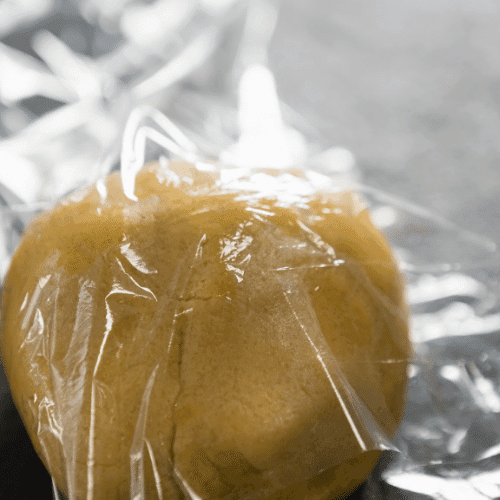
Homemade Pasta Recipe: Rolling It Out
Remove dough from the plastic wrap. Cut the disc into 4 equal pieces.
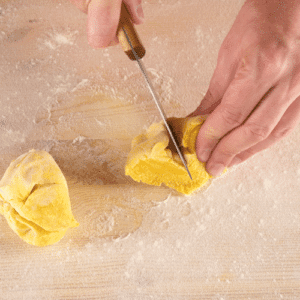
Using your hands or a rolling pin flatten each piece into an oval shape.
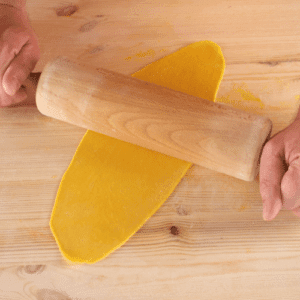
Using the pasta attatchment
Get your pasta attachment ready and roll the dough through it, starting with the widest setting, usually #1. Fold the dough in 1/2 after running through the 1st time. Run it through 2 x on each setting. After running through smallest setting, you will have a long sheet of smooth dough.


Using a knife
If you are using a knife, dust your countertop with flour and roll out the dough into a thin sheet using a rolling pin. Once you’ve got it thin enough, fold it up, and slice it into your desired pasta width with a sharp knife. Fettuccine, linguine, or tagliatelle, the choice is yours!
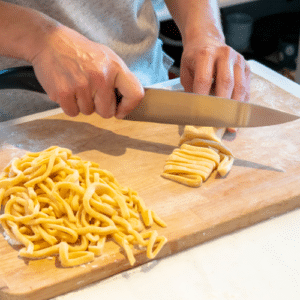
Cooking And Serving Homemade Pasta
Bring a pot of salted water to a rolling boil and cook your pasta for 2-3 minutes. Fresh pasta cooks quickly, so keep an eye on it! Once it’s al dente (firm to the bite), drain it and toss it with your favorite sauce. Tomato, basil, and mozzarella make a delightful combo.

How To Dry Homemade Pasta
Drying Homemade Pasta:
- Prepare the pasta: After making your pasta dough and shaping it into your desired pasta type (e.g., spaghetti, fettuccine, or shapes like bows or shells), let it rest briefly (about 30 minutes) on a floured surface to prevent sticking.
- Use a pasta drying rack: If you have a pasta drying rack, it’s the best tool for this job. Hang your pasta strands or shapes on the rack.
- Alternative drying methods: If you don’t have a pasta drying rack, you can also lay your pasta on a clean, dry towel or a lightly floured surface. Make sure they are well separated to prevent sticking.
- Allow to dry: Let the pasta dry for at least 24 hours or until it is completely dry and hard to the touch. The drying time may vary depending on the pasta type, humidity levels, and room temperature.
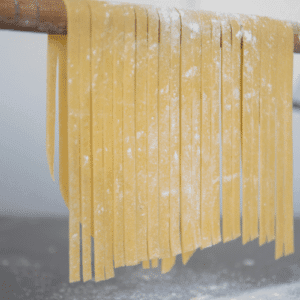
How To Store Homemade Pasta
- Store in an airtight container: Once your pasta is thoroughly dried, transfer it to an airtight container. You can use glass jars, plastic containers, or resealable bags. The goal is to keep moisture and air out.
- Add desiccant packets: If you live in a particularly humid environment, consider adding desiccant packets to the container to absorb any excess moisture and prevent the pasta from becoming soggy.
- Label and date: It’s a good practice to label the container with the type of pasta and the date it was made. This helps you keep track of freshness.
- Store in a cool, dry place: Store the sealed container in a cool, dry, and dark place. A pantry or cupboard works well. Avoid storing pasta near heat sources or in direct sunlight, as this can cause it to deteriorate faster.
- Use within a reasonable timeframe: Homemade dried pasta can typically be stored for several months to a year, but its quality will degrade over time. It’s best to use it within the first few months for the best flavor and texture.
When you’re ready to cook your homemade dried pasta, there’s no need to rehydrate it; simply boil it in salted water until it’s al dente, following the instructions for cooking times on the package.
By following these steps, you can enjoy your homemade pasta well beyond the day you made it while maintaining its quality.

Homemade Pasta Recipe: Endless Possibilities
Your homemade pasta is ready to shine in a variety of dishes. Toss it with a creamy Alfredo sauce, pile on some pesto, toss with tomatoes and vinaigrette go classic with marinara and meatballs. Homemade pasta elevates every meal to a whole new level.
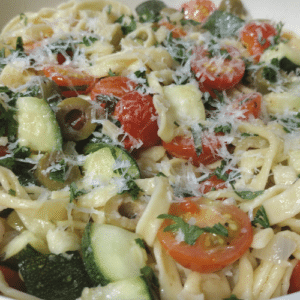
Whipping up homemade pasta is a fun kitchen adventure that yields delicious results. Whether you prefer the ease of a KitchenAid mixer or the satisfaction of using a knife, the process is worth every second. So, roll up those sleeves, get creative with your pasta shapes, and savor the homemade goodness. Bon appétit! Let’s Mix It Up!™
Other recipes you may like:
Apparel for the foodies & grillers

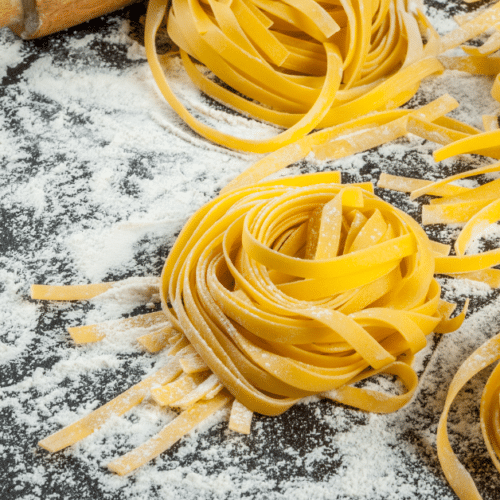
Homemade Pasta Recipe
Ingredients
- 2 cups all-purpose flour
- 3 large eggs room temperature
- 1 Tbsp olive oil
- 1/2 tsp salt
Instructions
- Clear a clean and spacious countertop or workspace. Place your KitchenAid mixer with the dough hook attachment nearby. Have the pasta roller and cutter attachments ready. If your mixing and rolling by hand see instructions in post above.
- In your stand mixing bowl, combine 2 cups of all-purpose flour and 1/2 teaspoon of salt. Mix them together. Make a well in the center. Crack the 3 large eggs into the well. Pour in the 2 tablespoons of olive oil.
- Start your KitchenAid mixer with the dough hook attatchment on the lowest setting to combine the ingredients. Allow the mixer to knead the dough for about 2-3 minutes until it comes together. If the dough looks too dry, you can add a little water, one tablespoon at a time, until it forms a ball. If it's too sticky, add a bit more flour.
- Once the dough has come together, increase the mixer speed slightly and knead the dough for about 4-5 minutes until it becomes smooth and elastic.
- Remove the dough from the mixer and form it into a ball. Wrap the dough in plastic wrap or cover it with a kitchen towel. Let the dough rest for at least 30 minutes at room temperature. This allows the gluten to relax and makes it easier to roll out.
- Divide the rested dough into 4 smaller portions, so it's easier to work with. Attach the pasta roller attachment to your KitchenAid mixer. Set the roller to the widest setting (usually 1).Flatten one portion of dough with your hands and feed it through the roller. Fold the dough in half and repeat the process, rolling it through several times until it becomes smooth and consistent. Gradually reduce the roller setting to your desired thickness. Switch to the pasta cutter attachment and pass the rolled dough through to create your desired pasta shape (e.g., fettuccine, spaghetti, or lasagna sheets).
- You can either cook the pasta immediately in boiling salted water for a few minutes or let it air-dry for long term storage. See instructions for drying in post above.
